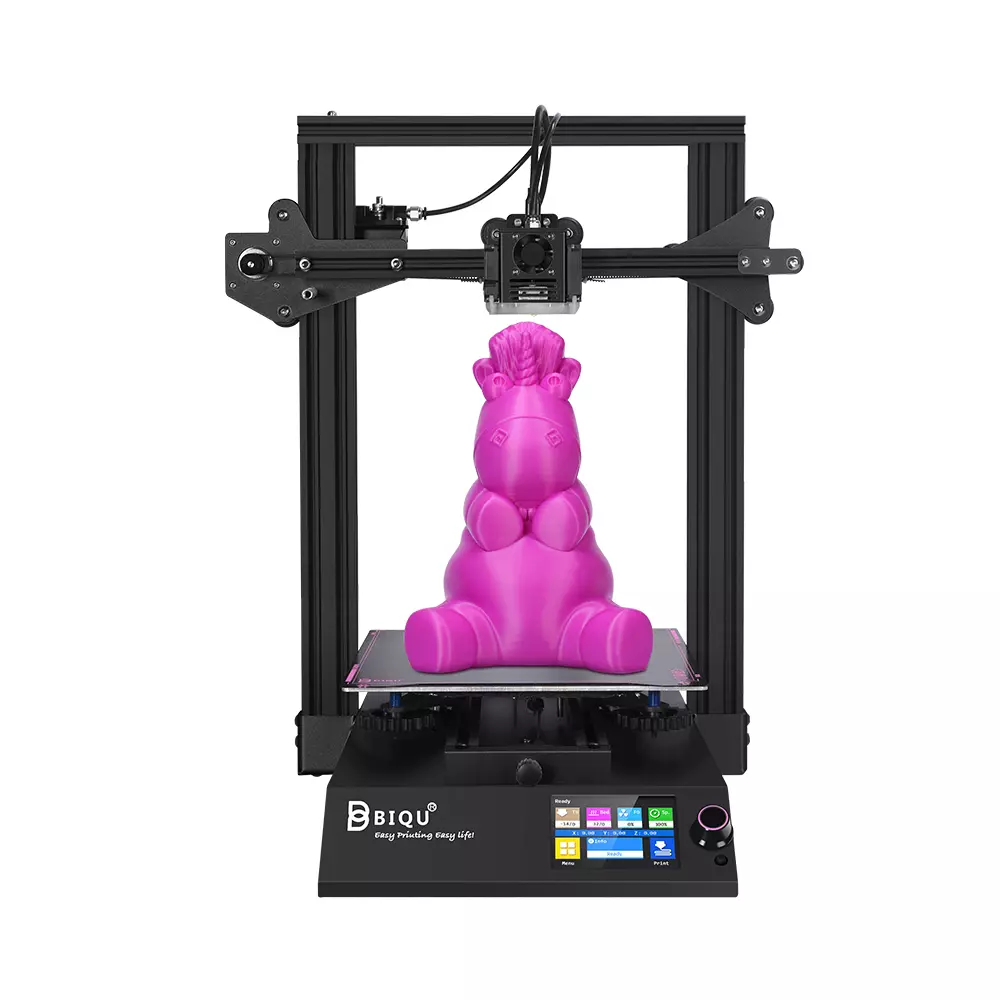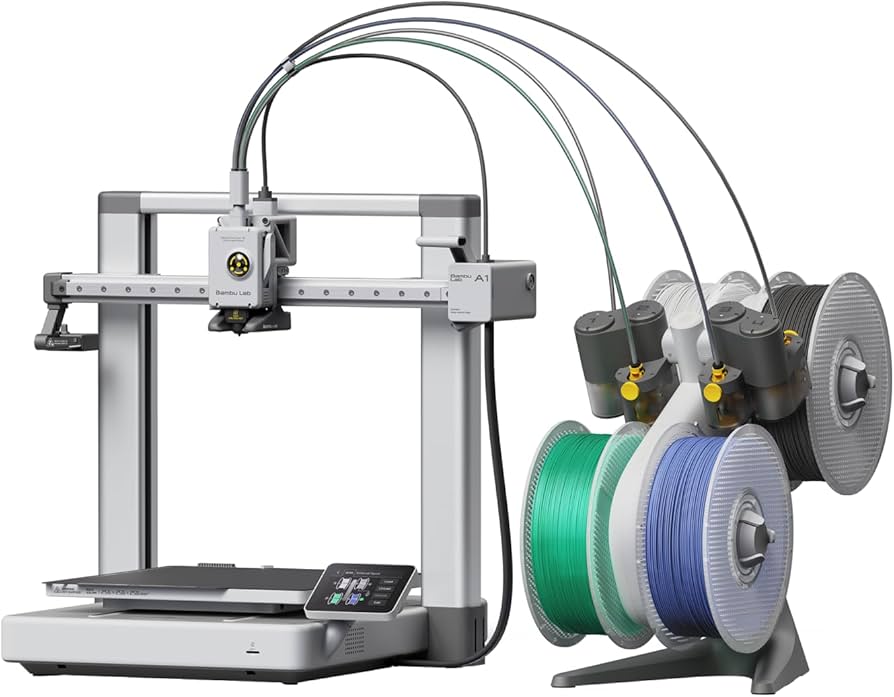Compare BIQU B1 vs A1
Comparison between the best 3D printers
Choose the best 3D printer at the best price. The cheapest 3D printers are here.
Buy a 3D printer here with 3D Fila.
 |
 |
|
| Model | BIQU B1 |
A1[BUY A1] |
| Printing Material | Filament | Filament |
| Buy Filament for BigTreeTech BIQU B1 | Buy Filament forBambu Lab A1 | |
| Estimated price | $269,00 | $700,00 |
| Manufacturer | BigTreeTech | Bambu Lab |
| Release Year | 2020 | 2023 |
| Print Volume [mm] | 235x235x270 | 256x256x256 |
| Printer Size [mm] | 412x402x492 | 385x410x430 |
| Weight [kg] | 8,00 | 8,3 |
| Power Loss Recovery | YES | YES |
| Enclosed printer | NO | NO |
| Bed Leveling | Manual | Automatic |
| Filament End Sensor | YES | YES |
| Bed type | Heated | Heated |
| Power supply system | Bowden | Direct Drive |
| Standard nozzle | 0,4 | 0,4 |
| Maximum Nozzle Temperature [°C] | 250 | 300 |
| Maximum Bed Temperature [°C] | 100 | 100 |
| Maximum printing speed [mm/s] | 100 | 500 |
| Filament holder | YES | YES |
| Camera for supervision | NO | NO |
| Recommended filaments | PLA, TPU, ABS, PETG | PLA, PETG, TPU, PVA |
| Recommended slicers | Cura, Simplify, Slic3r | SuperSlicer, PrusaSlicer, Cura, OrcaSlicer |
| Maximum Resolution [mm] | 0,1 | 0,1 |
| Processor | 32 Bits BTT SKR V 1.4 | |
| Display | Touchscreen TFT 3,5'' | Touchscreen 3,5 |
| Power Supply | 24V / 360W | 350 W |
| Connectivity | SD / USB | Wi-Fi, Bambu-Bus, Cartão Micro SD |
| Operating systems | Windows, Mac, Linux | Windows, Linux, Macbook |
| Date of registration in the system | 2021-04-14 | 2024-07-17 |
| Release date | 2020 | 2023 |
| Extra features | The BIQU B1 is an advanced 3D printer with a silent 32-bit BTT SKR V1.4 motherboard and ARM Cortex-M3 CPU, offering DIY interfaces (I2C, SPI, WiFi) and dual Z-axis. Its dual BTT B1 TFT35 V3.0 operating system allows real-time monitoring and multiple printing modes, including G-code visualization effects. It stands out for its BIQU SSS (Super Spring Steel), ensuring easy model adhesion and simplified removal, with the possibility of using it on both sides. It includes a filament sensor, automatically pausing printing in case of filament breakage. The multicolored RGB lights integrated into the hotend allow you to view the printing status even at night. Additional notes include the need for a BIQU-specific Type-C cable and extra interfaces for smart filament sensor and BL Touch. | The BambuLab A1 printer features fully automatic calibration, multi-color printing with the AMS system, active flow rate compensation, quick nozzle change with a clip, active motor noise cancellation, a build volume of 256x256x256 mm³, a maximum extruder temperature of 300°C, and a heated bed of up to 100°C. In addition, it has high precision, a machine health management system and an intuitive 3.5-inch touchscreen interface. |
| Support for multiple colors and materials (AMS and CFS) | NO | YES |
Notes * |
||
| Cost-benefit | 7 / 10 | 7 / 10 |
| Hardware | 2 / 10 | 4.8 / 10 |
| Tela | . | . |
| Print volume | 3 / 10 | 4 / 10 |
| Performance | 1 / 10 | 4 / 10 |
| [BUY A1] |
Conclusion |
| In comparing the BIQU B1 and Bambu Lab A1 3D printers, several key factors come into play that can influence the decision for potential buyers. First, the price difference is significant, with the BIQU B1 being a budget-friendly option and the Bambu Lab A1 positioned as a premium choice. This disparity naturally affects the overall value proposition. The BIQU B1 offers a solid performance for its cost, making it suitable for hobbyists or those looking for an affordable entry into 3D printing. However, its manual bed leveling and lower maximum printing speed may limit its usability for more advanced applications. On the other hand, the Bambu Lab A1, with its automatic bed leveling, significantly higher maximum printing speed, and advanced features such as multi-color printing capabilities and a robust health management system, appeals more to enthusiasts and professionals who seek enhanced performance and versatility in their projects. Both printers support a range of filaments, but the A1 provides better support for high-temperature materials, which could be crucial for users needing to print specialized designs. Furthermore, the A1 incorporates modern conveniences like a touchscreen interface and wireless connectivity, which the BIQU B1 lacks. In summary, if budget is the primary concern, the BIQU B1 offers good value with essential features for novices. Conversely, for users looking for advanced functionality, faster speeds, and better precision, the Bambu Lab A1 presents a more appealing option despite its higher cost. Ultimately, the choice between these two models should align with the buyer's specific needs, level of experience, and willingness to invest in potential capabilities. |

